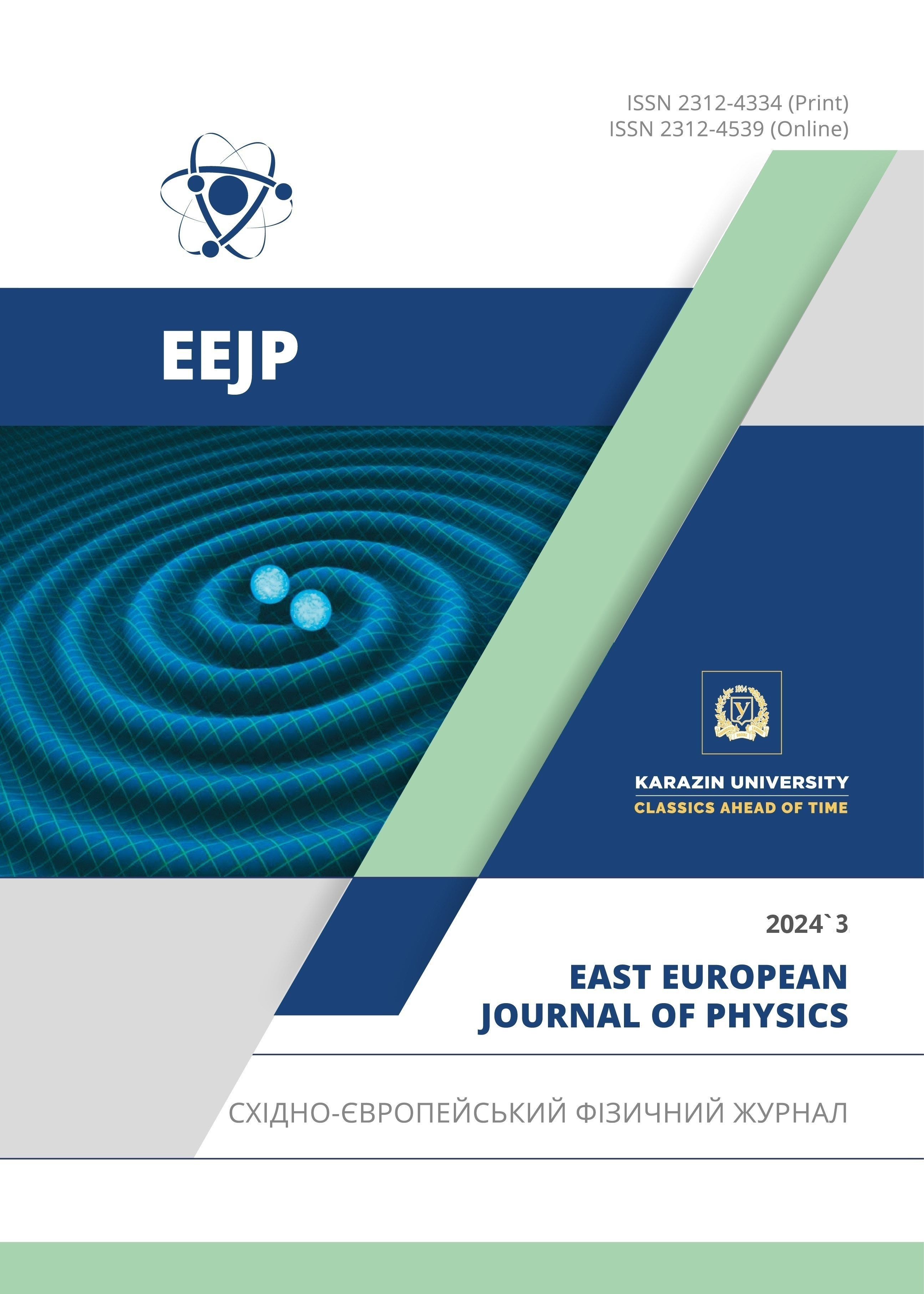Theory of Linear-Circular Dichroism in Monoatomic Layers of Transition Metal Dichalcogenides Taking into Account the Rabi Effect
Abstract
We have developed a theory of dimensional quantization for nanostructures, both one-dimensional and zero-dimensional, constructed from monoatomic layers of transition metal dichalcogenides (TMDCs). This theory has enabled us to derive expressions for the energy spectra of charge carriers in both even and odd states (relative to coordinate inversion), as these states occur within quantum-confined lines and points of the TMDC monoatomic layers, dependent on their geometric dimensions. Our numerical analysis provides a detailed exploration of the quantum-confined energy states of electrons within these nanostructures, offering insights into their potential applications in advanced nanoelectronic devices. This work not only advances our understanding of the energy characteristics of TMDC monoatomic layers but also contributes to the broader field of material science by exploring the effects of dimensional quantization on electronic properties.
Downloads
References
V.V. Mitin, V.A. Kochelap, and M.A. Stroscio, Introduction to Nanoelectronics Science, Nanotechnology, Engineering, and Applications, (Cambridge University Press, New York, 2008).
V.V. Mitin, V.A. Kochelap, and M.A. Stroscio, Introduction to Optical and Optoelectronic Properties of Nanostructures, (Cambridge University Press, 2019), pp. 414.
V.E. Gasumyants, S.N. Lykov, D.A. Pshenai-Severin, S.A. Rykov, and D.A. Firsov, Dimensional quantization. Part 1. Energy spectrum of nanostructures, (Publishing House of the Polytechnic University, St. Petersburg, 2008). (in Russian).
M. Baldo, Introduction to Nanoelectronics, (MIT Open Course Ware Publication, Cambridge, MA, 2011).
Sarma, Sankar Das, “Spintronics: A new class of device based on the quantum of electron spin, rather than on charge, may yield the next generation of microelectronics,” American Scientist, 89, 516-523 (2001).
S.A. Wolf, D.D. Awschalom, R.A. Buhrman, J.M. Daughton, S. Von Molnár, M.L. Roukes, A.Y. Chtchelkanova, et al., “Spintronics: a spin-based electronics vision for the future,” Science, 294(5546), 1488-1495 (2001). https://doi.org/10.1126/science.1065389
S.D. Bader, and S.P. Parkin, “Spintronics,” Annual Review of Condensed Matter Physics, 1, 71-88 (2010). https://doi.org/10.1146/annurev-conmatphys-070909-104123
W. Han, R.K. Kawakami, and M. Gmitra, “Graphene spintronics,” Nature Nanotechnology, 9(10), 794-807 (2014). https://doi.org/10.1038/nnano.2014.214
V.E. Gasumyants, S.N. Lykov, D.A. Pshenai-Severin, and D.A. Firsov, Dimensional quantization. Part 2. Optical and kinetic properties of semiconductor nanostructures, (Publishing House of the Polytechnic University, St. Petersburg, 2010). (in Russian).
V.R. Rasulov, R.Ya. Rasulov, B.B. Akhmedov, I.A. Muminov, and K.K. Urinova, “Dimensional quantization in InSb and GaAs in three-zone model,” Journal of Physics: Conference Series, 2697(1), 012005 (2024). https://doi.org/10.1088/1742-6596/2697/1/012005
V.R. Rasulov, R.Ya. Rasulov, I.M. Eshboltayev, M. Kuchkarov, and K.K. Urinova, “To the theory of dimensional quantization in crystals in the Kane approximation,” Journal of Physics: Conference Series, 2697(1), 012003 (2024). https://doi.org/10.1088/1742-6596/2697/1/012003
J. Knoch, Nanoelectronics: From Device Physics and Fabrication Technology to Advanced Transistor Concepts, 2nd edition, (De Gruyter, 2024).
R.Y. Rasulov, V.R. Rasulov, and I. Eshboltaev, “Linear-Circular Dichroism of Four-Photon Absorption of Light in Semiconductors with a Complex Valence Band,” Russian Physics Journal, 58(12), 1681–1686 (2016). https://doi.org/10.1007/s11182-016-0702-2
V.R. Rasulov, R.Ya. Rasulov, I.M. Eshboltaev, and R.R. Sultonov, “Size Quantization in n-GaP,” Semiconductors, 54(4), 429 432 (2020). https://doi.org/10.1134/S1063782620040132
V.R. Rasulov, “To the theory of electron passage in a semiconductor structure consisting of alternating asymmetric rectangular potential wells and barriers,” Russian Physics Journal, 59(10), 1699-1702 (2017). https://doi.org/10.1007/s11182-017-0963-4.
R.Ya. Rasulov, V.R. Rasulov, N.Z. Mamadalieva, and R.R. Sultanov, “Subbarrier and overbarrier electron transfer through multilayer semiconductor structures,” Russian Physics Journal, 63(4), 537-546 (2020). https://doi.org/10.1007/s11182-020-02067-7
M.M. Glazov, and E.L. Ivchenko, “Valley Orientation of Electrons and Excitons in Atomically Thin Transition Metal Dichalcogenide Monolayers (Brief Review),” Journal of Experimental and Theoretical Physics Letters, 113(1), 7–17 (2021). https://doi.org/10.1134/S0021364021010033
R. Y. Rasulov, V.R. Rasulov, K.K. Urinova, M.A. Mamatova, and B.B. Akhmedov, “Single and Multiphoton Optical Transitions in Atomically Thin Layers of Transition Metal Dichalcogenides,” East European Journal of Physics, (1), 393-397. https://doi.org/10.26565/2312-4334-2024-1-40
G.L. Bir, and G.E. Pikus, Symmetry and Strain-induced Effects in Semiconductors, (Wiley, New York, 1972). https://www.scirp.org/reference/ReferencesPapers?ReferenceID=13474
Ivchenko, E.L., Rasulov, R.Ya. Symmetry and real band structure of semiconductors. (Fan, Tashkent, 1989), pp. 126. https://koha.lib.tsu.ru/cgi-bin/koha/opac-detail.pl?biblionumber=125752.
E.L. Ivchenko, and G.E. Pikus, in: Superlattices and Other Heterostructures: Symmetry and Optical Phenomena, 2nd ed. (Springer-Verlag Berlin Heidelberg, 1997), pp. 38-70. https://doi.org/10.1007/978-3-642-97589-9
Copyright (c) 2024 Rustam Y. Rasulov, Voxob R. Rasulov, Mardon K. Nasirov, Makhliyo A. Mamatova, Islomjon A. Muminov

This work is licensed under a Creative Commons Attribution 4.0 International License.
Authors who publish with this journal agree to the following terms:
- Authors retain copyright and grant the journal right of first publication with the work simultaneously licensed under a Creative Commons Attribution License that allows others to share the work with an acknowledgment of the work's authorship and initial publication in this journal.
- Authors are able to enter into separate, additional contractual arrangements for the non-exclusive distribution of the journal's published version of the work (e.g., post it to an institutional repository or publish it in a book), with an acknowledgment of its initial publication in this journal.
- Authors are permitted and encouraged to post their work online (e.g., in institutional repositories or on their website) prior to and during the submission process, as it can lead to productive exchanges, as well as earlier and greater citation of published work (See The Effect of Open Access).








